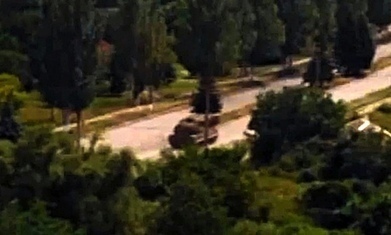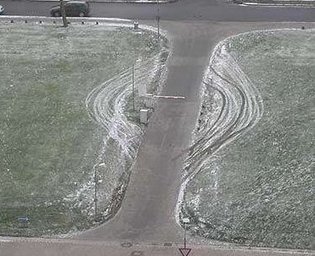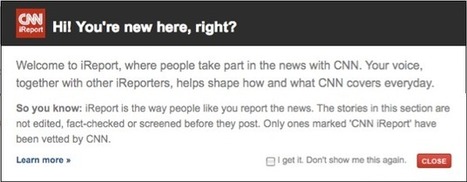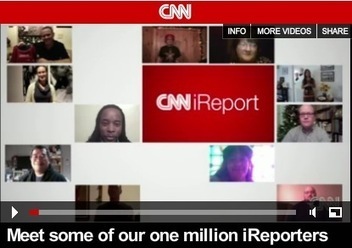 Your new post is loading...
 Your new post is loading...
Ben Cardew: Stories such as the shooting down of the Malaysia Airlines plane show the importance of checking Twitter and YouTube content.
In the aftermath of an event as tragically uncertain as the MH17 plane disaster, amid claim and counterclaim about who was responsible, it becomes ever more important for news organisations to verify the validity of material on social media.
This is where social news agency Storyful and its Open Newsroom come into their own. The Dublin-based company – acquired by News Corp for €18m in December 2013 – specialises in finding and verifying news content on social media. Open Newsroom, which Storyful launched on Google+ in June 2013, is “a real-time community of news professionals” whose objective is to “debunk, fact-check, clarify, credit and source” information around big news stories....
The best thinking about journalism’s future benefits from its being in touch with technology’s potential. But it can get in its own way when it simplifies and repudiates the intelligence of journalism’s past.
That is happening, to a degree, in a discussion gaining momentum lately that journalism should now largely move beyond fact gathering and toward synthesis and interpretation.
The NSA story is just the latest case that shows the importance, and the elusiveness, of simply knowing what has really happened.
In a Nieman Journalism Lab post, Jonathan Stray made the case recently for moving beyond facts, or what might be called The Displacement Theory of Journalism. “The Internet has solved the basic distribution of event-based facts in a variety of ways; no one needs a news organization to know what the White House is saying when all press briefings are posted on YouTube. What we do need is someone to tell us what it means.”...
Guardian digital development editor Joanna Geary answers some questions about GuardianWitness.... ...First up: this was built in two months. The sponsorship pot from EE gave them a budget and time to get the job done, but not necessarily have everything they wanted at launch. She says it's a complete, working system that can be built upon. I suggest the phrase "minimum viable product" to Jo but she suggests that it's a full product - one that will be built on. Do they have aspirations for more integration with social media? Yes, they do. And it's something they're looking at as the system develops. The key part of the development which is invisible to us right now is that the Guardian Witness system is deeply integrated with the Guardian's CMS. Once the content has passed through verification, it's available to the journalists, and they can insert it into a story or liveblog just by inserting an URL, which creates an embedded version of the contribution that links back to the contributor's profile. "The really exciting thing is not what you see now, but what you see when Witness is included in a story," she says. It's a tool to facilitate genuine collaborative working between the journalist and external witnesses. Jo says they'll collaborate with people on the ground, or with expert knowledge, in any way they can - and already do, via phone and other traditional methods. This adds another tool for doing that....
...You can access the app via the Web, but there’s also native incarnations for Android and iOS. To contribute content to GuardianWitness, you need to create an account, either using your existing Guardian credentials, or through your Facebook and Twitter details. The Guardian actually posts ‘assignments’, inviting users to post content based on themes – for example, when Britain experiences unseasonably bad weather. Editors set a range of assignments each week, covering news, sport, culture and life and style....
...Most journalists spend the majority of their time reporting what a mayor said in a prepared statement, writing stories about how parents can save money for university tuition, covering the release of the latest versions of popular electronic devices, or finding out if a sports figure’s injury will affect performance in the next match. Most cover news in a fairly formulaic way, reformatting information released by others: the agenda for the next town council meeting, the half dozen most interesting items from the daily police reports, what performances will take place this weekend, and the quarterly financial results of a local employer. These standard stories are merely aggregations of information supplied by others. At one time these standard stories served useful purposes because newspapers were the primary information hubs of the community. Today such routine information has little economic value because the original providers are now directly feeding that information to the interested public through their own websites, blogs, and Twitter feeds. Additionally, specialist topic digital operators are now aggregating and organizing that information for easy accessibility.... [The challenge for news media with the proliferation of social media and self publishing by everyone from city councils and corporations to citizens? Finding less available news and adding more value to it.]
In the past week we've seen an uprising of angry people, mostly women, offended by the Susan G. Komen Foundation cutting off funding for breast cancer exams at Planned Parenthood clinics. It's just the latest example of how the global news conversation is in the hands of people, not just "the media." And it's what I had in mind over a dozen years ago when I talked about the rise of a new kind of people's journalism....
...This is iReport’s fifth anniversary, and a CNN spokesperson calls it “the most developed and active citizen journalism platform of any news organization worldwide.” It claims 1,002,428 registered iReporters, and 2.4 million unique users each month. King said iReport has had content submitted from every country on earth. While some iReporters are freelance journalists, or aspiring journalists, most are unconnected to the press. All are unpaid. They see something, shoot a video or photo, and upload it to the site. Others eschew breaking news contributions and instead upload videos of themselves offering commentary about politics, world affairs or local issues. The steady stream of content submitted from people the world over is a boon to CNN, but represents a major verification challenge....
CNN iReport, the network’s global participatory news community announces a major milestone – the platform has reached more than one million registered contributors. The news comes on the heels of a complete overhaul of the iReport site last November, the launch of Open Story, a storytelling tool that allows the community to participate in the news in real time and the release of a custom built app for Android. iReport continues to set the standard in citizen journalism and has further plans to grow the platform in 2012.... [But is PR ready? JD]
Twitter may be the biggest change in how news is done since the teletype... The idea of everyone becoming a broadcaster or reporter in the age of the Internet is not new--even I wrote about it in my book on crisis management in 2001. But, the profound change in the way news is done is becoming more obvious every day....
|
It is perhaps fitting that the first on-scene report on the Asiana airplane crash came not from a traditional correspondent but via social media in the form of a Samsung executive and one-time online media boss who was also a passenger on the ill-fated plane.In his first tweet, David Eun, the former president of AOL Media and Studios, calmly laid out the dramatic story for a quickly growing worldwide audience:"I just crash landed at SFO. Tail ripped off. Most everyone seems fine. I'm ok. Surreal"...
“Will anyone with information please come forward”. It’s a refrain we always hear police echo in crime-dramas. People are too afraid to come forward though for lack of trust in the official authorities or fear of gangs. That’s especially in poverty-stricken, gang-ridden areas. You can easily imagine the classic scene: New York cops at a ghetto crime scene with apartment residents hiding behind their curtains. Then again, we are constantly documenting massive amounts of potential evidence each time we post a photo via Instagram, a video via Vine or even a report by sending out an ‘eyewitness tweet.’ How do we filter the valuable truth from the inevitable noise of social media?
In the wake of the Boston Marathon, I have but one ask for the media: please tell us NO.... ... While Twitter might offer up a 6-second video of one of yesterday’s horrific explosions, it’s your profession that is charged with relaying that information. In the race for clicks, pageviews, and traffic, I’ve seen the most trusted news sources with banner three-letter monikers devolve into sensationalized sites catering to this now now now generation’s demand for anything. “Anything — just give us anything,” we cry. But it would be lovely if you told us “no.” No – we will not capitalize on over-graphic images that would get a Hollywood blockbuster an R-rating. No – we will not use cultural or nationality indicators when reporting that there is a suspect in custody. Why? Because we know the most important words in those statements are “in” and “custody” as opposed to where one was born or the depth of one’s suntan....
TV and social media coverage of Boston bombings was repetitive and speculative. The story will unfold in coming days.... The Steve Silva boston.com footage of the Boston marathon finish line explosion is the new World Trade Tower plane implosion is the new Zapruder tape. Another national horror leaves a scar. We know the drill: The moment of violent disruption, the sense of shock oddly mediated by the screen, replayed endlessly — now on every platform. The repeated images become mere images, first shocking then numbing. At some point, perhaps to distance ourselves from the pain, we focus on the conflicting reports of the smallest detail: how many seconds elapsed between the first explosion and the second? First we heard “a few.” Then a more definitive “13 seconds.” Then “between 10 and 20.” Every network had a different count. At some point we started counting ourselves, timing the moments with every replay. Could’ve been 13, but the speed of sound is faster than the speed of video, isn’t it? We were told that cell service was disrupted so as not to set off additional bombs. That report was then retracted. We heard the JFK Library had a third bomb. That report later knocked down. A suspect was held at Brigham and Women’s Hospital. Authorities later said not so. More unexploded bombs? Maybe, maybe not. Information moves faster than knowledge and still the finish-line explosion footage rolls....
My experiences from the front carriage of the May 9th CrossCountry train crash where our train hit 12 cattle at high speed near Oxford. These are the tweets that got used by a lot of the mainstream media to cover this incident, with me as the 'citizen journalist'. My name also trended on Twitter....
A startup is hoping to combine two hot web trends, crowd sourcing and microearning, into a single savior for cash-strapped, broadcast newsrooms. Rawporter, an iPhone app that will soon be rolled out for Android, turns almost anyone into a local news cameraman or camerawoman. Instead of dispatching a camera crew to a fire during rush hour and risk they won't get there until after the flame is out, a television news reporter can create an assignment from Rawporter's Web interface and send it to anyone with the app who may be in the area of the fire.... [Interesting development - JD]
Yesterday, CNN reported it now has one million registered iReporters in its citizen journalism community. Imagine. Is PR ready? So with such big challenges, what’s a PR pro to do? Here are a few initial ideas...
Last week, CNN sacked over 50 staffers, many of them camera-lugging photojournalists, in part because it will lean more heavily on its citizen journalism outfit iReport for more, better content. With Monday's relaunch of iReport as a "social network for news," CNN's strategy of shifting various tasks from its paid journalists to the five-year-old network of iReporters is coming into focus. We doubt that CNN will soon replace news anchors with holograms any time soon, but the network is trending towards giving its citizen journalists more assignments, surfacing more of their content on TV and generally making iReport content more of an editorial fixture. And feature-by-feature, there's little doubt that CNN wants the new iReport to be a money-saver as well as a scoop factory....
This an absolutely fascinating, superb visualization of revolution tweets... a must-view...
|



 Your new post is loading...
Your new post is loading...























Verification is a challenge for journalism and citizen journalists alike.